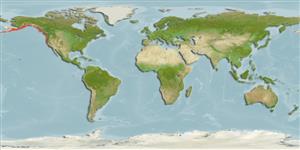Environment: milieu / climate zone / depth range / distribution range
Ecología
marino demersal; rango de profundidad 9 - 183 m (Ref. 2850). Temperate; 63°N - 37°N, 169°E - 121°W
Northeast Pacific: southeastern Bering Sea and Aleutian Islands to Monterey Bay, central California. Specimens reported from Peter the Great Bay and Aniva Bay are not Liparin pulchellus.
Tamaño / Peso / Age
Maturity: Lm ? range ? - ? cm
Max length : 25.0 cm TL macho / no sexado; (Ref. 2850)
Short description
Claves de identificación | Morfología | Morfometría
Espinas dorsales (total) : 0; Radios blandos dorsales (total) : 47 - 53; Espinas anales: 0; Radios blandos anales: 39 - 41. Caudal reduced but distinct.
Found on soft bottoms (Ref. 2850). Feed on crustaceans and polychaete worms (Ref. 6885). Taken by shrimp trawlers operating down to 92 m (Ref. 6885).
Life cycle and mating behavior
Maturities | Reproducción | Spawnings | Egg(s) | Fecundities | Larva
Eschmeyer, W.N., E.S. Herald and H. Hammann, 1983. A field guide to Pacific coast fishes of North America. Boston (MA, USA): Houghton Mifflin Company. xii+336 p. (Ref. 2850)
IUCN Red List Status (Ref. 130435)
Threat to humans
Harmless
Human uses
Herramientas
Special reports
Download XML
Fuentes de Internet
Estimates based on models
Preferred temperature (Ref.
123201): 4.1 - 9.3, mean 6.5 °C (based on 146 cells).
Phylogenetic diversity index (Ref.
82804): PD
50 = 0.5000 [Uniqueness, from 0.5 = low to 2.0 = high].
Bayesian length-weight: a=0.00525 (0.00237 - 0.01161), b=3.15 (2.96 - 3.34), in cm total length, based on LWR estimates for this (Sub)family-body shape (Ref.
93245).
Nivel trófico (Ref.
69278): 3.6 ±0.56 se; based on food items.
Generation time: 3.7 ( na - na) years. Estimated as median ln(3)/K based on 1
growth studies.
Resiliencia (Ref.
120179): Medio, población duplicada en un tiempo mínimo de 1.4-4.4 años (K=0.30; Fec=940).
Fishing Vulnerability (Ref.
59153): Low to moderate vulnerability (33 of 100).
